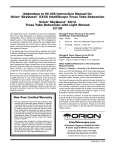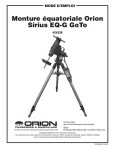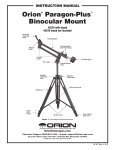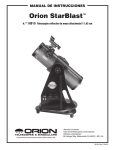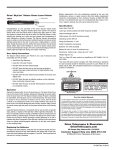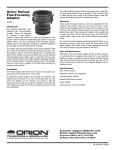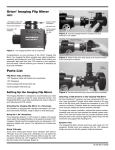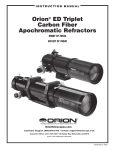Download Orion LASERMATE 5684 User's Manual
Transcript
instruction Manual Orion® LaserMate™ Pro #5684 Providing Exceptional Consumer Optical Products Since 1975 OrionTelescopes.com Customer Support (800) 676 -1343 E-mail: [email protected] Corporate Offices (831) 763 -7000 89 Hangar Way, Watsonville, CA 95076 IN 386 Rev. A 03/10 your eyepiece holder. You will be able to obtain repeatable accurate alignment of your telescope’s optics. If your telescope has a 2" focuser you will need to use a 1.25" adapter to use the LaserMate Pro components. We recommend using the Orion Precision Centering Adapter for best results. Sight tube Marking the Primary Mirror In order to achieve the best accuracy when collimating with the Orion LaserMate Pro, you will need to have the primary mirror center marked. All Orion Newtonian reflectors and many other commercially available optical tubes are center marked from the factory. If your mirror already has a center mark you may skip ahead to the next section of this manual. Power button housing Telescope insert portion Laser lens Figure 1. The components of the LaserMate Pro Newtonian reflectors perform at their best when their mirrors are accurately aligned. While it’s not difficult to do, collimation can be a chore if you do not have the proper tools. The Orion LaserMate Pro provides a clear, intuitive way to determine if your telescope’s mirrors need adjustment, and which adjustments need to be made. With the highly precise two step alignment provided by the LaserMate Pro, you’ll be enjoying better, crisper views in no time! The LaserMate Pro has a lifetime alignment guarantee. Its durable, hardened design will ensure the laser beam is parallel to the 1.25" barrel that slides into Applying the center mark can be easily achieved using a supplied collimation target. You can create a paper target to locate the precise center of your mirror. The steps to do so are outlined below. Placing a target on the center of your mirror will not affect the light gathering of your mirror since the target will be placed behind the secondary mirror. Remove the primary mirror cell from your telescope. If you are unsure how to do this, consult your telescope’s instruction manual. Remove the mirror from the mirror cell. To do this, unscrew and remove the mirror clips. You can now lift the mirror off of the cell. Handle the mirror by its edges only, and be careful not to touch the surface with your fingers. Note: If the primary mirror is glued into its cell, it is not necessary to remove it from the cell. Get a clean sheet of paper that is big enough to cover the entire mirror’s surface. For large diameter mirrors, you may need to tape several sheets of paper together. Lay the primary mirror on the paper and trace its outline with a pencil. User Safety Precautions As with all laser products, the LaserMate Pro is not a toy and is intended for use by adults only. • Avoid Direct Eye Exposure. • Do not shine the laser into or near the eyes of people or animals. Direct eye contact with beam or bright reflection may cause eye injury. • Do not shine the laser toward moving vehicles of any kind, even distant ones. • Do not shine the laser toward anyone operating machinery. • Do not shine the laser at aircraft. Shining lasers at aircraft may be considered a felony. 2 WARNING: The LaserMate Pro emits laser radiation, so it is important not to shine the beam into your or anyone’s eye. During the collimation procedure, it is also important to avoid direct reflections of the laser beam into your eye. Rather, look only at off-axis reflections to determine the position of the laser spot on the mirrors. It is safe to view the laser when it is reflected off a surface that will diffuse the light, such as the bottom surface of the LaserMate Pro. It is also safe to view the reflection off a mirror surface as long as the beam is not directed into your eye. Because of the potential danger from the laser beam, store your LaserMate Pro out of the reach of children. 3 Before You Begin Collimating Using the LaserMate Pro 2. 3a. 3b. Figure 2. Trace the outline of the mirror on the paper. Figure 3a, 3b. Fold the paper circle in half, and then in half again. Accurate collimation of your telescope’s optics using the LaserMate Pro will most easily be achieved if you do a rough collimation of the optics with your eye first. This is because if the optics are grossly misaligned, it may be confusing to interpret which surfaces the laser is being reflected off of. Refer to your telescope’s instruction manual for the procedure on how to do a rough collimation with your eye. Note About Centering the Secondary Mirror Under the Focuser 4. 5. 6. Figure 4. Cut the tip off the paper wedge. Figure 5. Place the template on the mirror surface and carefully register its edge. Figure 6. Affix the ring label to the mirror surface through the hole in the template. Figure 7. The primary mirror’s center is now marked, and it is ready to be reinstalled. 7. Next, cut out the circle you have just traced with a pair of scissors. Fold the paper circle into quarters by folding the circle precisely in half, and then folding it in half again. Now, cut about 1/4 inch off the tip of the paper wedge you have created. Unfold the paper, and you will find that you have a paper template of your mirror with a hole at the center. Make sure the template is still clean; place the paper template over the surface of the primary mirror. Carefully register the template edge with the edge of the mirror. Now, take one of the supplied collimation targets and affix it to the center of the mirror’s surface through the hole of the paper template. The center of the primary mirror is now marked, and you can reinstall the primary mirror in the telescope. Note: For mirror cells that use mirror clips to secure the primary mirror in place, it is important not to over tighten the mirror clips. For Orion reflector telescopes, tighten the mirror clip anchor screws until just snug, and then back off each screw by 1/2 turn. Over tightened mirror clips will put stress on the primary mirror’s figure, and will introduce astigmatism into the optical system as a result. 4 Red laser spot Figure 8. Place a piece of white paper in front of the open tube. If you see a laser spot on the paper, be careful not to place your eye in that position. Centering the secondary mirror under the focuser is an adjustment that can be made with the aid of the LaserMate Pro, but it requires marking the center of the secondary mirror in the same way the center of the primary mirror was marked. This is generally undesirable due to the large area of the supplied collimation targets compared to the total area of the secondary mirror. Since centering the secondary mirror under the focuser is an adjustment that very rarely, if ever, needs to be done, we recommend simply making this adjustment by eye. Again, refer to the collimation instructions in your telescope’s manual for the procedure on how to do this. If you wish to use the LaserMate Pro for centering the secondary mirror under the focuser, refer to the appendix section at the end of this manual. Adjusting the Tilt of the Secondary Mirror The first collimation adjustment made with the LaserMate Pro will be to adjust the tilt of the secondary mirror. This is performed with the Laser collimator. Insert the LaserMate Pro into your telescope’s focuser drawtube. Point your optical tube so that it is level with the horizon to limit the play in the eyepiece holder. You want the LaserMate Pro to be “balanced” as possible in the focuser. Secure it in place by lightly tightening the thumbscrew on the drawtube that holds the eyepiece. Then turn the LaserMate Pro on by pressing the red button on the top of the unit until it clicks on. Before looking into the optical tube, take a sheet of white paper and place it across the front aperture of the telescope. If you see a red laser spot on the sheet of paper, then your telescope is considerably out of collimation (Figure 8). Take note of the position of the red spot, and be careful not to place your eye in that position. Remember, it is safe to view the reflection of the laser beam off mirror surfaces as long as the beam is not directed into your eye. Look down the front of the optical tube. Remember to keep your eyes clear of any direct reflections of the beam. Notice the red spot on the surface of the 5 primary mirror itself; this is the laser beam being reflected from the secondary mirror off the surface of the primary mirror. The red spot should be centered on the primary mirror’s surface. If it isn’t, adjustments will be need to be made to the secondary mirror’s tilt. This is done with the secondary mirror collimation screws, usually located on the central hub of the telescope’s spider vane assembly. In the case of Orion reflectors there are three recessed 2mm Allen screws surrounding the center Phillips-head screw. Do not loosen this center screw. The Allen screws work on a push-pull basis, loosen one and tighten another until you achieve the correct position of the laser in the target. Make sure all three screws are firmly tightened against the mirror holder upon completion to ensure the mirror holds its position. Consult the owners manual of your telescope for instructions pertaining to other optical tubes. Make minor adjustments to the telescope’s secondary mirror collimation screws until the reflection of the laser beam is centered on the primary mirror. If your primary mirror is center marked the red spot should fall directly in the center of the collimation target. Primary mirror center mark Laser spot on primary mirror Reflection of primary mirror clip b. Before a. Figure 10. Collimating the optics. (a) When After Figure 9a, 9b. To center the red laser spot on the primary mirror, you will need to adjust the tilt of the secondary mirror. Adjusting the Tilt of the Primary Mirror The final collimation adjustment is to adjust the tilt of the primary mirror. Remove the laser and use the sight tube eyepiece to complete this step. It may be helpful to have someone looking through the eyepiece while another person makes adjustments to the collimation screws on the back of the telescope. Otherwise you will need to make minor adjustments at the back of the telescope and check them through the peephole sight tube eyepiece at the front. This does not affect accuracy but the process will take a little bit longer. The primary mirror will need adjustment if, as in Figure 10d, the secondary mirror is centered under the focuser and the reflection of the primary mirror is centered in the secondary mirror, but the small reflection of the secondary mirror (with the “dot” of the peephole sight tube eyepiece) is off-center. Consult your telescope’s manual for information regarding specific collimation adjustments. Now, try tightening or loosening one of the collimation thumbscrews with your fingers. Look into the focuser and see if the secondary mirror reflection is at the the center of the primary. You can tell this easily with the sight tube and mirror center mark by simply watching to see if the “dot” is moving closer or farther away 6 drawtube the mirrors are properly aligned, the view down the focuser drawtube should look like this (b) With the collimation cap in place, if the optics are out of alignment, the view might look something like this. (c) Here, the secondary mirror is centered under the focuser, but it needs to be adjusted (tilted) so that the entire primary mirror is visible. (d) The secondary mirror is correctly aligned, but the primary mirror still needs adjustment. When the primary mirror is correctly aligned, the “dot” will be centered, as in (e). from the ring on the center of the primary mirror. When you have the dot centered as much as possible in the ring, your primary mirror is collimated. The view through the sight tube should resemble Figure 10e. An optional star test is the most accurate method to determine if your optics are accurately collimated. c. d. Star-Testing the Telescope When it is dark, point the telescope at a bright star and accurately center it in the eyepiece’s field of view. Slowly de-focus the image with the focusing knob. If the telescope is correctly collimated, the expanding disk should be a perfect e. 7 Out of collimation Collimated Figure 11. A star test will determine if a telescope’s optics are properly collimated. An unfocused view of a bright star through the eyepiece should appear as illustrated on the right if the optics are perfectly collimated. If the circle is unsymmetrical, as in the illustration on the left, the scope needs collimation. circle (Figure 11). If the image is unsymmetrical, the scope is out of collimation. The dark shadow cast by the secondary mirror should appear in the very center of the out-of-focus circle, like the hole in a donut. If the “hole” appears off-center, the telescope is out of collimation. If you try the star test and the bright star you have selected is not accurately centered in the eyepiece, the optics will always appear out of collimation, even though they may be perfectly aligned. It is critical to keep the star centered, so over time you will need to make slight corrections to the telescope’s position in order to account for the sky’s apparent motion. Collimation of the optical system is now complete. Go out and enjoy the view! The alignment of the mirrors should not need to be adjusted again unless the telescope is handled roughly. If you handle the telescope gently during transport, then only slight adjustments will need to be made to the mirrors. Use the LaserMate Pro before each observing session to check and make adjustments to the mirrors as needed. Care and Maintenance of Your LaserMate Pro a. b. Figure 12a-b. To access the battery compartment simply unthread the power button housing assembly. be handled with care. Although alignment is guaranteed for life common sense care should be taken to keep the LaserMate Pro or its components from being damaged. It should not be exposed to water, dust, heat or sunlight. To extend battery life store in a cool, dry environment. Installing New Batteries When the LaserMate Pro’s laser beam starts to dim or completely fades, it is necessary to install a new battery. To change the battery, you must remove the top of the LaserMate Pro’s power button housing. Simply unthread the top and remove the battery. The LaserMate Pro requires one CR123A battery. Place the battery in the opening so that the positive (+) terminal is facing the open end of the battery compartment. Remove the spent battery and install the fresh battery. The batteries should be inserted so that the positive (+) end of the battery faces the open end of the battery compartment. After installing a fresh battery, replace the top of the LaserMate Pro power button assembly. Battery life is approximately three hours, so remember to keep the LaserMate Pro turned off when not in use to maximize battery life. Your LaserMate Pro is manufactured of the highest quality components and is carefully aligned and tested at the factory. Like all electronic equipment, it should 8 9 Specifications Appendix: Centering the Secondary Mirror Under the Focuser Laser power: Less than 5mW Laser wavelength: 635-655nm Alignment: ± 3 arcmin Focuser size: 1.25" Case: Aluminum, gray anodized Battery: CR123A Certification: Meets all FDA regulations applicable at the time of manufacture Compliance This is a Class 3R laser product as classified per EN/IEC 60825-1 : 2007. This Class 3R laser product complies with FDA performance standards for laser products except for deviations pursuant to Laser Notice No. 50 dated June 24, 2007. No scheduled maintenance is necessary to keep this product in compliance. In order to use the LaserMate Pro to center the secondary mirror underneath the focuser, you must mark the center of the secondary mirror. Do this by first removing the secondary mirror from the telescope and making a paper template the same way you made a template for the primary mirror. Use the template and one of the remaining collimation targets to mark the secondary mirror’s center. Reinstall the secondary mirror once its center has been marked. Place the LaserMate Pro into the telescope’s focuser and turn it on. Now, peer into the optical tube and look at the primary mirror. Notice the reflection of the secondary mirror on the primary mirror; you will see a bright red spot on the secondary mirror where the laser beam is reflecting off it. The red spot should be exactly at the center of the collimation target on the secondary mirror. If it is not, you will need to make adjustments to the secondary mirror’s position until it is. For adjustments perpendicular to the optical axis, lengthen and shorten the spider vanes. For adjustments parallel to the optical axis, loosen or tighten the screw centered in the spider’s central hub. You may also need to adjust the rotation of the secondary mirror relative to the focuser. Caution: Use of controls or adjustments or performance of procedures other than those specified herein may result in hazardous radiation exposure. LASER LIGHT, AVOID DIRECT EYE EXPOSURE, CLASS 3R LASER PRODUCT 10 11 One-Year Limited Warranty This Orion LaserMate Pro is warranted against defects in materials or workmanship for a period of one year from the date of purchase. This warranty is for the benefit of the original retail purchaser only. During this warranty period Orion Telescopes & Binoculars will repair or replace, at Orion’s option, any warranted instrument that proves to be defective, provided it is returned postage paid to: Orion Warranty Repair, 89 Hangar Way, Watsonville, CA 95076. If the product is not registered, proof of purchase (such as a copy of the original invoice) is required. This warranty does not apply if, in Orion’s judgment, the instrument has been abused, mishandled, or modified, nor does it apply to normal wear and tear. This warranty gives you specific legal rights, and you may also have other rights, which vary from state to state. For further warranty service information, contact: Customer Service Department, Orion Telescopes & Binoculars, 89 Hangar Way, Watsonville, CA 95076; (800) 676-1343. Orion Telescopes & Binoculars OrionTelescopes.com 89 Hangar Way, Watsonville, CA 95076 Customer Support Help Line (800) 676-1343 12







